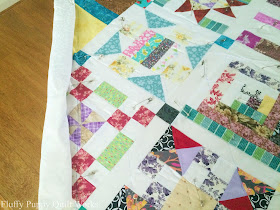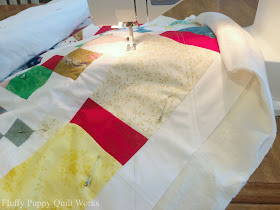This simple straight line quilting design looks great on a variety of quilt tops. You'll love how you don't have to pay attention to any of the seams in your quilt top; this all over quilting stitch doesn't have to be lined up in any special way!
I find this MUCH easier than stitching in the ditch, and it can look more elegant then simple straight lines in a single direction. It's easy to change the amount of quilting by simply changing the distance between your lines. For my quilt, I spaced my lines 5" apart. The quilt measures 72" x 82", a somewhat small full size. Make sure you check how far apart your batting will let you quilt before deciding how you space your lines. I used cotton batting that said I could space the lines up to 8" apart. I have yet quilt lines 8" apart, but I could have made my lines 8" apart and quilted a lot less if I had wanted to. If you want a quilt that is stiffer and more dense, quilt your lines close together. For a softer quilt, sew your lines farther apart.
Supplies
- Fabric marking pen or pencil.
- Quilting ruler, at least 6" x 18". 8" x 24" is preferred. You can do this with a smaller quilting ruler, but it will take a LONG time to mark the lines. If you are making something small such as a table runner or potholders, a smaller ruler should be fine.
- Optional: Extra basting pins to hold down the quilt as you roll it to fit under the machine.
- Optional: A walking or even feed quilting foot. I don't always use one of these, but they do make it easier. Research to find the proper one for your machine.
General Quilting Tips
- Use good quality thread. Good thread will run through the machine smoothly, and it won't break as often. Also, experiment with threads of different weights (thicknesses). Some sewing machines work best with the same threads being used for the top thread and bobbin. This is how my machine is. Other machines my run better with a super thin bobbin, with a medium weight top thread being used. Sometimes when a thin bobbin thread is used, the machine runs badly because the thread jumps around the bobbin.
- Have a fresh needle in your machine. It is usually recommended that you change the needle after every 8-10 hours of sewing. If you are doing a lot of quilting through a mid-loft batting or thicker, some quilters recommend changing the needle every 6-8 hours. I have used both universal and quilting needles to quilt. For thinner batting, I find that the universal and quilting needles produce the same quality seam. When I use thicker batting or I am quilting over a lot of seams, the quilting needles seem to work better for me.
- Make sure your sewing machine is clean inside and has recently been oiled. I clean and oil my machine every 2-3 weeks. I run my sewing machine at least 1-2 hours every day, more if I am currently quilting a large quilt. How often you clean and oil your machine depends on what machine you have, and what type of project you are working on. Quilt batting causes a large amount of dust to build up in my machine so I need to clean it sooner if I have been quilting rather than just piecing. Refer to your sewing machine manual to see if there are instructions on how often your machine should be cleaned.
- Use the proper presser foot for the type of quilting you are doing. Most sewing machine manuals will tell you the proper foot to use. If your sewing machine has a presser foot pressure (say "presser foot pressure" three times fast!) adjustment knob, adjust the presser foot to the proper pressure before you begin quilting if needed. Most likely you will need to adjust this if you are using thick batting.
- Baste your quilt well using your preferred method. You can use basting pins, basting spray, or even baste it using hand sewn stitches. I like basting pins because I can take them in and out of the quilt as needed. You may find that you like different basting methods for different quilt sizes. Find what works for you!
Tutorial
Step 1: Use your quilting ruler to and fabric marker to mark a line on the corner of the quilt. This line should be about 45 degrees from the edge of the quilt top. If your ruler has 45 degree markings, use them. If not, don't worry, it doesn't have to be perfect.
 |
| The colors in this first photo are not quite right. I increased the saturation to make it easier to see the ruler markings and the edge of the quilt. |
Step 2: Use your quilting ruler to mark lines about 3"-6" apart. Whatever distance you decide, all the lines should be that same distance apart. I made my lines 5" apart.
Continue marking these lines all across the quilt. The lines on your quilt should resemble the diagram below.
Step 3: As you mark these lines, start rolling up your quilt at the corner. This makes it much easier to handle the quilt and fit it under the machine.
If you want to, you can use basting pins to hold down the rolled up part of the quilt. Roll it up as you mark lines until you have just a little corner left.
Step 3: Sew down the lines. After sewing down each line, sew a second line about 1/4" away from the first one. You can just use the edge of your presser foot as a guide. This way you don't have to mark extra lines.
 |
| A second seam is sewn 1/4" away from the original line. |
As you sew, roll up the part of the quilt that has been quilted.
The photo below shows the rolled up quilt under the machine.
Keep rolling up the quilt as you sew!
Once you have over half of the quilt quilted, switch the quilt around so the quilted part is no longer under the machine. Instead, the part that has not been quilted goes under the machine. This way, the smaller roll goes under the machine since you are half way done. If you do this, sew your second lines on the opposite side of the marked lines. Before, I quilted my second lines on the left side of my first lines. Since I flipped the quilt around, I then sewed on the right side of the lines.
The seams on your quilt should resemble the diagram below.
Step 4: Mark lines perpendicular to your original lines. These lines should be the same distance apart as your first set of lines. Just as before, sew a second line about 1/4" away from the marked lines, using your presser foot as a guide.
Happy quilting!

























Very clear instructions and photos and a great result to unify the quilt.
ReplyDeleteThank you for the tutorial! The straight line pattern is great for a scrappy quilt.
ReplyDeleteGreat tutorial Abby! I usually do free motion quilting, I do terrible at stitch in the ditch! Thanks for sharing!
ReplyDeleteThis comment has been removed by the author.
DeleteThank you Connie! I can't get the hang of stitch in the ditch. At least I am not along, lol!
DeleteDo you quilt your lines in the same direction or do you turn at the end of the line and quilt the opposite way.
ReplyDeleteHi Judy! I like to take the quilt off the machine after every line to adjust the rolled up parts of the quilt and any pins that need taken out or added. Then, I usually quilt in the same direction I sewed the previous lines in. It takes more time to keep taking the quilt off the machine, but it helps to prevent wrinkles in the backing and makes it easier for me to handle the quilt as I sew. Also, I check the thread tension after every line. This way, if the tension becomes off, I will catch it right away.
DeleteThank you Abby. I have a quilt top that I am going to try this on. Thanks for your instructions.
ReplyDeleteThank you I am new to quilting and this tutorial will be very helpful!😀
ReplyDeleteThank you for putting this tutorial together. Great instructions!
ReplyDelete